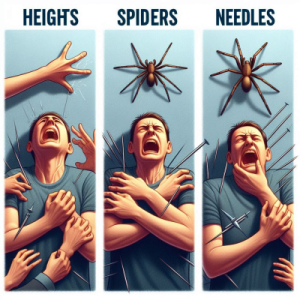Imagine standing at the edge of a dizzying cliff, your heart racing as the ground seems to pull away beneath you. For many, this isn’t just a moment of fear; it’s a reflection of acrophobia, one of the most common phobias that grips people worldwide. You might find it surprising how deep-rooted these fears can be, influencing daily choices and interactions. As we explore the landscape of phobias like arachnophobia and claustrophobia, you may start to wonder: what drives these intense reactions, and how can they be addressed?
Arachnophobia: Fear of Spiders
Arachnophobia, often  described as a debilitating fear, can grip individuals with an intensity that disrupts daily life. If you’ve ever found yourself frozen at the sight of a spider, you’re not alone. This fear can stem from a combination of evolutionary instincts, learned behaviors, and personal experiences.
described as a debilitating fear, can grip individuals with an intensity that disrupts daily life. If you’ve ever found yourself frozen at the sight of a spider, you’re not alone. This fear can stem from a combination of evolutionary instincts, learned behaviors, and personal experiences.
Understanding spider behavior can help demystify these creatures, making it easier for you to confront your fears. Most spiders are harmless and play essential roles in ecosystems, yet their appearance can trigger overwhelming anxiety for those with arachnophobia.
Treatment options for arachnophobia can vary, but they often include exposure therapy, cognitive behavioral therapy (CBT), and relaxation techniques. Exposure therapy gradually exposes you to spiders in a controlled, safe manner, allowing you to desensitize yourself to the fear.
CBT helps you reframe negative thoughts associated with spiders, reducing anxiety levels. Additionally, relaxation techniques, such as deep breathing or mindfulness, can empower you to manage your panic responses when you encounter a spider.
You might also consider joining support groups or seeking guidance from a mental health professional who specializes in phobias. Remember, facing your fear doesn’t have to be a solitary journey.
Acrophobia: Fear of Heights
Heights can evoke a profound sense of dread for those grappling with acrophobia, the fear of being in high places. You might find yourself feeling dizzy, sweating, or even trembling when confronted with a tall building, a steep hill, or a high balcony.
This height-related anxiety isn’t just an inconvenience; it can greatly impact your daily life, making it difficult to engage in activities that others may take for granted, like enjoying a scenic view or traveling.
Understanding acrophobia involves recognizing its roots, which can range from traumatic experiences to a predisposition toward anxiety disorders. You might recall a past incident that shaped your fear, or it could stem from a general tendency to feel anxious in unfamiliar situations.
Whatever the cause, it’s important to acknowledge that you’re not alone in this struggle.
Overcoming acrophobia requires a blend of mental strategies and gradual exposure. Cognitive-behavioral therapy (CBT) is often effective, helping you reframe negative thoughts associated with heights.
You can also engage in gradual exposure, where you slowly confront your fear by taking small steps—perhaps starting with lower heights and gradually working your way up.
Support from friends or a therapist can further ease this journey. By addressing your height-related anxiety head-on, you can reclaim experiences that once felt out of reach and find joy in the heights again.
Overcoming acrophobia is possible, and with determination and support, you can regain control over your fears.
Claustrophobia: Fear of Enclosed Spaces
In tight spaces, claustrophobia can trigger intense feelings of panic and discomfort, making situations like riding in an elevator or sitting in a crowded room unbearable for those affected. This fear often stems from the perception of being trapped in enclosed environments, which can lead to a fight-or-flight response.
As you encounter these situations, your mind may race with thoughts of losing control or being unable to escape, intensifying the anxiety.
Understanding the roots of claustrophobia is essential. It may be linked to past traumatic experiences or learned behaviors. Acknowledging this fear is the first step toward managing it. You’re not alone; many individuals share this struggle, and recognizing commonality can offer comfort.
To cope with claustrophobia, you can adopt several coping strategies. Breathing techniques, such as deep, slow inhalations, can help reduce anxiety when you find yourself in an enclosed environment.
Visualization can also be beneficial; imagining a peaceful, open space can provide mental relief. Gradual exposure to confined spaces, starting with less intimidating situations, may help desensitize your fear over time.
Additionally, mindfulness practices can ground you in the present moment, allowing you to detach from overwhelming thoughts. Seeking support from friends, family, or a mental health professional can further enhance your ability to navigate these challenges.
Agoraphobia: Fear of Open Spaces
While claustrophobia focuses on the fear of enclosed spaces, agoraphobia presents a different challenge: the fear of open spaces or situations where escape might be difficult. If you experience agoraphobia, you might find yourself avoiding crowded places, public transportation, or even leaving your home altogether. This fear isn’t just about the open spaces themselves; it often intertwines with social anxiety, leading to feelings of helplessness when faced with the prospect of being in public.
Understanding agoraphobia can help you identify its roots. It often stems from past traumatic experiences, panic attacks, or overwhelming anxiety in social situations. You might feel trapped when you can’t control your surroundings, which exacerbates your fear. It’s vital to acknowledge these feelings without judgment, as they’re valid and affect many people worldwide.
Coping strategies can play an important role in managing agoraphobia. Gradual exposure to feared situations, starting with small steps, can help desensitize you to anxiety triggers. Incorporating relaxation techniques, such as deep breathing or mindfulness, can also assist you in calming your mind during stressful moments.
Seeking support from a therapist or joining a support group can provide valuable tools and encouragement along the way.
Cynophobia: Fear of Dogs
Cynophobia, the intense fear of dogs, can greatly impact daily life, making simple outings a source of anxiety. When you encounter a dog, whether on the street or in a friend’s home, your mind may race with thoughts of potential danger. This fear often stems from negative past experiences or an innate sensitivity to canine behavior, leaving you feeling vulnerable and overwhelmed.
Understanding canine behavior can be vital in managing cynophobia. Dogs communicate through body language, and recognizing signs of aggression or fear can help you feel more in control. For instance, a dog wagging its tail may not always be friendly; context matters.
Educating yourself about different breeds and their temperaments can also ease your anxiety, as some breeds are known for their gentle nature.
Engaging in dog training can further empower you. By learning techniques to approach dogs safely and confidently, you create a sense of security around these animals.
Gradual exposure, starting with calm, well-trained dogs, can help desensitize your fear. You might even consider working with a therapist or a dog trainer who specializes in helping individuals face their fears.
Conclusion
As you navigate the shadows of your fears, remember you’re not alone in this battle against phobias. Each heartbeat quickens in the presence of a spider or the edge of a high ledge, but there’s hope in understanding and confronting these fears. Think of the freedom that awaits on the other side—imagine stepping into an open space, where the weight of anxiety lifts, and you reclaim your life. With the right support, you can transform your fears into triumphs.





